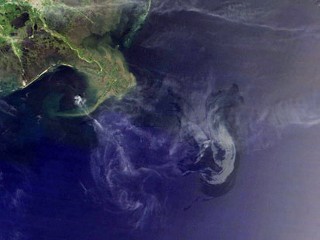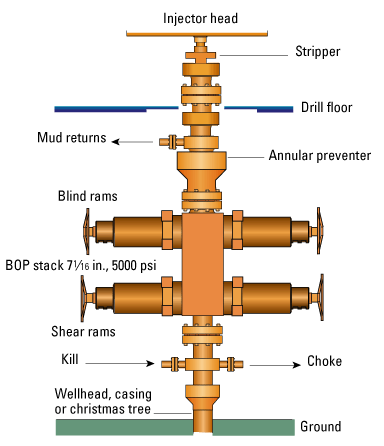The BP disaster in perspective
 Monday, May 17, 2010 at 12:06AM
Monday, May 17, 2010 at 12:06AM  NASA image by way of ABC News. Nansen Saleir op-ed in WSJ. Saleri is president and CEO of Quantum Reservoir Impact in Houston, so an oil man.
NASA image by way of ABC News. Nansen Saleir op-ed in WSJ. Saleri is president and CEO of Quantum Reservoir Impact in Houston, so an oil man.
Why didn't the oil industry anticipate such a big disaster, asks Saleri.
The answer may partially lie in the extraordinary safety record of offshore U.S. drilling over the last four decades. The last significant mishap in U.S. waters dates back to 1969, the year of the first lunar landing. A blowout on Union Oil's Platform A, six miles offshore from Santa Barbara, Calif., spilled an estimated 80,000 to 100,000 barrels of crude oil over a period of 10 days. This resulted in considerable environmental damage and loss of wildlife, including 10,000 birds. The ensuing chain of technical and procedural improvements in safety practices worked pretty well. The end result was an infinitesimal spill rate over several decades which in turn led many, including BP, to consider a blowout an inconceivable event.
His solution-process going forward strikes me as solid:
So what now? What is needed is a scientific, thorough and apolitical investigation headed possibly by the National Academy of Sciences and drawing in experts from the oil and gas industry as well as the government agencies involved. The investigation must also evaluate the entire post-accident response effort led by BP in cooperation with local, state and federal agencies.
Some questions that must be diligently probed by investigators are:
1) Why did the blowout preventers—the massive valve assemblies designed to stop an uncontrolled flow—fail? And what are their reliability statistics?
2) Were the redundant safety systems truly redundant? It seems obvious they weren't, but this has to be verified.
3) How well trained was the crew?
4) Were the safety systems and contingency plans in place commensurate with the immense values of the total assets at risk—human, material and environmental?
5) Did operational and cost-cutting practices compromise safety?
What escalated the April 20 incident from a tragic accident to a catastrophe was not the blowout itself but the ensuing inferno that sunk the $650 million BP platform. Without the fire, the oil well leak could have probably been brought under control within a week. Thus it is critical to determine what future designs could best enhance survivability of giant offshore structures even under blowout conditions. Are there lessons to be learned from the airline industry, which has engineered significant reductions in post-crash fires during the last decade?
So treat it like the Challenger disaster, which Saleri notes didn't end the US space program.
The Gulf provides about 1/3rd of US domestic production.










Reader Comments (2)
I roughnecked the Bryson Sands in the mid-70s. Worm hole, threw the chain, moved up into the derrick. I've made mud, sent it down the hole. That said, I listened to 60 Minutes interview of Mike Wilson, Escape from Deepwater Horizon.
The tragedy is clear: This disaster is a failure of leadership, a failure of management, abetted by cultural obedience to a chain-of-command.
This failure is a consequence of men under pressure *NOT* openly questioning one another *BEFORE* they decide to ignore compromise in the BOP, then risk drilling through redundant plugs, safety check points.
A technical problem, yes. But a human nature problem, more.
I concur. From the 60 minutes piece the similarities to the Challenger disaster are eerie what with BP "Management" overriding established engineering standards for the sake of expediency. The Chain of Command is precisely the problem and the way I was taught that you avoid these kinds of problems is that Quality Assurance (which in this case would be Safety Assurance) HAS to report directly to the CEO and no one else. Those who make decisions that will be unpopular have to be seperately empowered, protected, and incentivized organizationally, or they will be forever subject to the influence of factors that they cannot care about and do their job right.